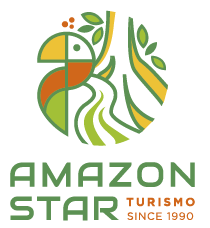The Amazon in brief
- The largest rainforest in the world covering 2.5 million sq.mi. in 9 countries
- The Amazon river system is the planet’s largest body of fresh water
- The Amazon basin, with 6 million sq.km. of river and jungle is the world’s largest in terms of drainage and volume. It holds 2/3 of all the fresh flowing water in the world
- The Amazon river system has 1,100 tributaries (17 with more than 1,000 mi. in length) and a total of 48,000 mi. of navigable rivers
- The Amazon river it, at times, so wide (up to 7 mi.) that you cannot see the opposite river bank
- The flow of the Amazon river is 12 times that of the Mississippi
- Known species: 15,000; 1,800 of butterflies, 4 big cats; 200 mosquitoes; 1,200-2,000 of fish; 2,650 of birds.
The Amazon Rainforest
The term rainforest describes forests that grow in constant humid conditions. They can occur wherever the annual rainfall is above 2,000 millimeters (80 in.), even if spread throughout the year. The rather high temperatures favor plant development – i.e. above 20 degrees Celsius.
The main characteristic of this humid, dense forest is the fact that the plants congregate in groups, organised in a distinctive manner in the ecosystem. Contrary to popular belief, tropical trees are not oversized. Average height is 30 to 40 meters (100 to 133 feet).
The Amazon Rainforest is the largest area of tropical forest in the world. It covers 6 million square kilometres in 9 different countries (circa 60% in Brazil). At first look, the forest seems rather uniform in physiognomy but in fact there are many typological variations and an ample biodiversity. The forest canopy is frequently discontinuous, giving space for ecological niches and crossing the heart of this region the huge Amazon river and a complex networkd of tributaries. The Amazon is the second longest watercourse in the world and holds more than 20% of the earth’s fresh water. With, at least 1,000 tributaries, the list of its tributaries includes 10 of the longest rivers in the world, Purus, Tocantins, Japurá, Juruá, Negro, Xingu, Guaporé, Iriri, Juruena all with more than 1,000 km / 700 mi. long. The Amazon Rainforest has four types of vegetation:
Terra Firma Forest (upland forest) – on higher grounds with no direct influence from the rivers
Várzea Forest (marshland forest) – seasonally flooded lowland forest
Igapó Forest – permanently flooded lowland forest
Caatinga Forest – along Negro river, also called Campirana.
Emergent trees
Rainforests have a distinctive structure. Above a sea of green, called the “upper canopy”, tower just a few “emergent trees” per acre, sometimes taller than 40 m (over 130 ft.). These are the only tree in all the forest that enjoy unfettered access to the sun and sky. They disperse their seeds by wind and are the home of birds like the reatures that inhabit them—birds like the harpy eagle and toucan—are very different from those found at lower levels.
Canopy
Most photosynthesis occurs in the canopy—that vast carpet of green which Alexander von Humboldt called a “forest above a forest”—which absorbs as much as 90% of the sunlight, darkening the lower levels. Here, 20-30 meters up (65-100 feet), live butterflies; mammals like three-toed sloths, moving slowly but efficiently in search of vegetation, descending only once a week to the ground to defecate. Temperatures reach 32 degrees C (96 F) but humidity is 60% (compared to 90% further down). Since this is where photosynthesis occurs, this is where productivity is greatest: each year a tropical rainforest produces about 25-30 tons of new growth per acre (10-12 tons), twice as much as a temperate oak forest.
Understory
In a virgin rainforest, the understory is not the “jungle” of tangled vines seen in old movies, or observed from boats on one of the thousands of rivers and tributaries also nourished by heavy rains. Undisturbed rainforest is surprisingly clear of vegetation close to the ground in part because so little light filters down through the canopy, sometimes only 1% to 2% of the sun’s original intensity. But even here life struggle is intense and insects, fungi and roots fight for access to energy, the raw material of existence. Temperatures are cooler, averaging 28ºC (82ºF) but humidity is higher, about 90%.
The extraordinary wealth of plant and animal life in the Amazon basin has attracted explorers and scientists since the dawn of the 16th century. At least 30,000 out of 100,000 species of plants in Latin America are found in the Brazilian Amazon. Wildlife is equally diverse: there are thousands of creatures, amazingly different but each ideally suited for its particular ecosystem.
A world apart, fascinating and intriguing, its tales and inhabitants will face the challenges that lie ahead: preservation, global warming and sustentability.
